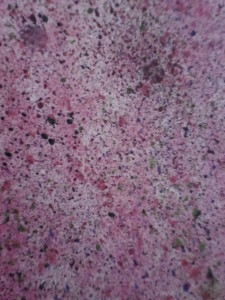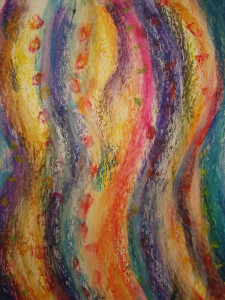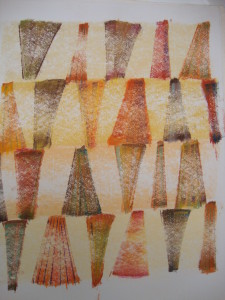“The creative process is not like a situation where you can get struck by a single lightning bolt. You have ongoing discoveries, and there’s ongoing creative revelations. Yes, it’s really helpful to be marching towards a specific destination, but along the way, you must allow yourself room for you ideas to blossom, take root, and grow.” ~ Carlton Cuse
 For a few years now I have taken assorted visual arts classes – drawing, printmaking, watercolour and abstract painting – in part to develop my repertoire of skills for teaching young children, but moreso to push my own creative boundaries and gain some mastery of something that has always kind of scared me. Anyone who reads my blog knows that from time to time I write about my angst around creativity, and my fear of the blank page. I know that for me there are a lot of factors that have fed my fear and these have included: limited prior experience, inadequate art instruction in school, insufficient role models, and little social support or guidance. My issues seem to have their roots in my early environment…essentially not enough sunlight and water to help my creativity grow! I don’t mind admitting that I have a pretty loud and vocal inner critic, one determined to make me doubt my own abilities. On more than one occasion it has persuaded me to give up on things when they seemed hard at first instead of persevering, and I regret listening to it. However, the balance of power between my inner critic any my recent determination to create something, anything, with a free, uninhibited and spontaneous mindset, seems to have shifted.
For a few years now I have taken assorted visual arts classes – drawing, printmaking, watercolour and abstract painting – in part to develop my repertoire of skills for teaching young children, but moreso to push my own creative boundaries and gain some mastery of something that has always kind of scared me. Anyone who reads my blog knows that from time to time I write about my angst around creativity, and my fear of the blank page. I know that for me there are a lot of factors that have fed my fear and these have included: limited prior experience, inadequate art instruction in school, insufficient role models, and little social support or guidance. My issues seem to have their roots in my early environment…essentially not enough sunlight and water to help my creativity grow! I don’t mind admitting that I have a pretty loud and vocal inner critic, one determined to make me doubt my own abilities. On more than one occasion it has persuaded me to give up on things when they seemed hard at first instead of persevering, and I regret listening to it. However, the balance of power between my inner critic any my recent determination to create something, anything, with a free, uninhibited and spontaneous mindset, seems to have shifted.
“The creative process is a process of surrender, not control.” ~ Julia Cameron
This summer, while taking an abstract drawing course, I read a book I stumbled upon,  called Manage Your Day-to-Day: Build Your Routine, Find Your Focus and Sharpen Your Creative Mind (edited by Jocelyn K. Glei). There are great insights about social media and how it can distract us from higher creative purposes. The chapter on sharpening the creative mind really spoke to me. It addresses balancing the hard work demanded by creative projects with taking time to play, relax and explore. Engaging in “unnecessary creativity” is vital to building confidence, developing skills, expressing ideas without placing restrictions on them, and just having fun. The book talks about how listening to your inner critic, or being a perfectionist can sabotage your efforts to engage in the act of creating. Suggested strategies for helping the mind to create include: wandering, resting, using limitations to problem-solve, exercising, meditating and considering a problem from a different perspective. Barriers to creativity are examined. Is more research required? Would taking a break be helpful if feeling uninspired? Are there concerns about what a creation might reveal about you? Are there personal problems, or a lack of funds, time, information or social support? And - for me this is a biggie - is scheduling time dedicated to creating a priority? The book gave me a lot to think about and as I considered the ideas and even tried some, I felt my confidence increase and found another door to creative expression begin to open for me.
called Manage Your Day-to-Day: Build Your Routine, Find Your Focus and Sharpen Your Creative Mind (edited by Jocelyn K. Glei). There are great insights about social media and how it can distract us from higher creative purposes. The chapter on sharpening the creative mind really spoke to me. It addresses balancing the hard work demanded by creative projects with taking time to play, relax and explore. Engaging in “unnecessary creativity” is vital to building confidence, developing skills, expressing ideas without placing restrictions on them, and just having fun. The book talks about how listening to your inner critic, or being a perfectionist can sabotage your efforts to engage in the act of creating. Suggested strategies for helping the mind to create include: wandering, resting, using limitations to problem-solve, exercising, meditating and considering a problem from a different perspective. Barriers to creativity are examined. Is more research required? Would taking a break be helpful if feeling uninspired? Are there concerns about what a creation might reveal about you? Are there personal problems, or a lack of funds, time, information or social support? And - for me this is a biggie - is scheduling time dedicated to creating a priority? The book gave me a lot to think about and as I considered the ideas and even tried some, I felt my confidence increase and found another door to creative expression begin to open for me.
 Of course this confidence is owed in large part to my amazing art teacher who has exposed me to all kinds of unexpected sources of ideas and inspiration for the drawings and paintings I have created. These include: natural areas, books, historical images, food courts, underpasses, murals, cemeteries and others. All of my senses have been engaged and I have been encouraged to move beyond what I can see, and to put on paper what I imagine and feel. More and more I reach for colours and materials without second guessing myself, and make marks without hesitating. At last creativity is blossoming and I am finding a voice as an emerging artist. Though I have a lot to learn about technique and colour theory, and how to talk about art, I am less fearful of the process of creating, of reflecting on my work as part of that process, and of receiving constructive feedback. I don’t worry anymore about my art being “bad” and instead focus on what my artistic exploration teaches me. This has been a significant part of my journey, of learning to give in to creating, and learning to just let go.
Of course this confidence is owed in large part to my amazing art teacher who has exposed me to all kinds of unexpected sources of ideas and inspiration for the drawings and paintings I have created. These include: natural areas, books, historical images, food courts, underpasses, murals, cemeteries and others. All of my senses have been engaged and I have been encouraged to move beyond what I can see, and to put on paper what I imagine and feel. More and more I reach for colours and materials without second guessing myself, and make marks without hesitating. At last creativity is blossoming and I am finding a voice as an emerging artist. Though I have a lot to learn about technique and colour theory, and how to talk about art, I am less fearful of the process of creating, of reflecting on my work as part of that process, and of receiving constructive feedback. I don’t worry anymore about my art being “bad” and instead focus on what my artistic exploration teaches me. This has been a significant part of my journey, of learning to give in to creating, and learning to just let go.
“Creative process gives me the most freedom because I can do anything I want on a piece of blank media.” ~ Sasha Pivovarova


Hi Angelique. Your abstracts are beautiful. I really like what you have to say about the creative process. I’m sure there is a link between these and your love of knitting. I love to draw but also judge myself harshly as I seem to make so little progress. I’ve just looked again at my copy of “ Drawing from the mind, painting from the heart by Annette Carroll Compton. Her suggested activities motivated me to keep on making marks. All children start out drawing. Why do so many people drop this satisfying way of expressing ourselves or simply taking time to look at what is around us?